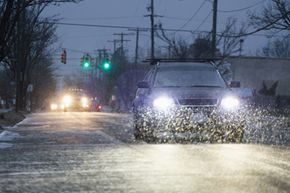You know how it is: The snow starts flying and cars start sliding off the road. When you lose control of your car in foul weather, the best you can hope for is a few minor dings and scratches. A catastrophic collision due to loss of control in the snow is something that everyone would rather avoid. That's when car companies come waltzing in with ads showing all-wheel-drive cars plowing through snowy roads and fields, thanks to their "extra grip" and "secure handling." Are those car companies telling the truth? Is all-wheel drive all we need to stay safe on snowy roads?
To find out, you need to understand how all-wheel drive works. All-wheel drive is a system that allows differing amounts of engine power to be sent to a car's wheels, depending on which wheels have the most traction. Traction is the amount of friction (though we usually experience it as "grip") between a wheel and the road. In a front-wheel-drive car, power is sent only to the front wheels. In rear-wheel-drive cars, power is sent only to the rear wheels. In both of those cases, half of the power gets sent to each of the drive wheels. In cars with four-wheel drive, an equal amount of power is sent to all four wheels. With all-wheel drive, however, the car can sense which wheels have the most traction and send power only to those wheels. When an all-wheel drive system detects a loss of traction and control, it reduces power to the slipping wheels.
Advertisement
Whew! Only 200 words left and I still haven't answered the question.
In theory, it sounds like all-wheel drive is always safer in the snow than other drive setups. But the efficacy of an all-wheel-drive system still depends on one crucial element: traction. And you don't get traction with all-wheel drive. You do, however, get it with snow tires.
All-wheel drive can help get a car begin moving in snow because it increases the odds that at least some of the tires are going to gain traction. However, all-wheel drive doesn't help a vehicle brake faster or decrease stopping distance in the snow. Stopping is a pretty good way of avoiding a car accident, so the fact that all-wheel drive doesn't help in that way is a pretty big downside. All-wheel drive can also give drivers a false sense of security, leading them to take risks they wouldn't normally take in a two-wheel-drive car. I live in New England, and I can't begin to tell you how many all-wheel drive Subarus I've seen spun-out on the side of the road during the winter months.
Yes, all-wheel drive gives drivers a little more control in snowy weather, but that doesn't mean it's always the safest choice. Good snow tires and a careful driver behind the wheel will trump all-wheel drive any day.
Advertisement


